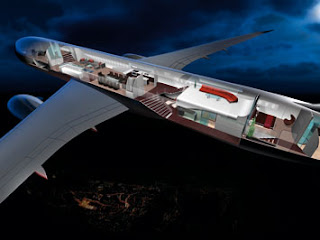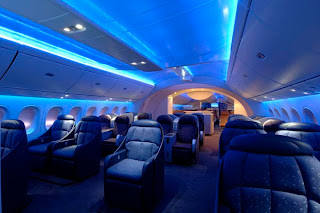The attacks on the Twin Towers occurred in 2001 brought profound changes to the entire world economy, especially in the value of oil. Virtually all industry sectors felt the high fuel prices, but there are few activities that are so sensitive to this difficulty as commercial aviation.
It was not long until the consumption of 15,000 liters of fuel for every hour of flight of the majestic Boeing 747-400 started to be too costly for airlines, considering the slump in demand for tickets.
Adding financial problems to the new wave of concern about the environment that began to emerge, the need for a modern and economical aircraft was evident. After almost ten years of development, research and delays, Boeing answer came with the
Boeing 787 Dreamliner.
Once Boeing announced to be open for orders of new aircraft in 2007, the 787 has already set a record, the largest number of preorders for a commercial jet. More than 50 different customers ordered 677 units, with deliveries beginning dated to 2008.
However, the first Dreamliner only fly in late September 2011, three years later than promised. Furthermore, develop and build the "dream aircraft" also proved to be more difficult and expensive than expected, considering that the total cost of the project has already reached $ 32 billion.
The first and most important innovation to be noticed is the fuel economy. Adding the high efficiency of the new engines to lighter materials and improved aerodynamics, the Boeing 787 can be up to 20% more efficient than any other plane of the same size.
Furthermore, the Dreamliner can operate both with Rolls-Royce as with General Electric, giving companies greater flexibility when required maintenance. Another important aspect (especially for those who live close to airports) is the reduced noise that the engines produce.
The wings, fuselage and many other parts of the aircraft were built with reinforced carbon fiber instead of the traditional iron and steel, causing the aircraft to be much lighter without losing its strength.
One of the features that drew the most attention of the first passengers who might experience a trip on the 787 windows were large and modern. In place of the old plastic curtain, the Dreamliner uses an electronic system that makes the window become lighter or darker, something like the lens of the glasses that darken in the sun.
The distinct shape of the wings, combined with an intelligent system that regulates the wing surface also makes the Dreamliner pass smoothly through turbulent wind currents. Boeing ensures that passengers will feel the 787 eight times less queasy during turbulence, and less frightened.













.jpg)